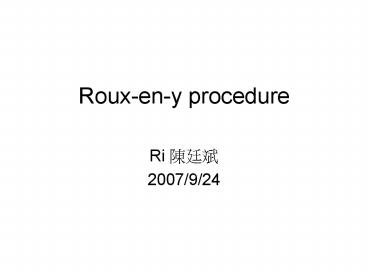Roux-en-y procedure - PowerPoint PPT Presentation
1 / 26
Title:
Roux-en-y procedure
Description:
Small proximal gastric pouch. Gastric pouch constructed of cardia. to prevent ... Postvagotomy atony. Incomplete vagal transection. Early dumping syndrome ... – PowerPoint PPT presentation
Number of Views:354
Avg rating:3.0/5.0
Title: Roux-en-y procedure
1
Roux-en-y procedure
- Ri ???
- 2007/9/24
2
Indication
- for preventing persistent vomiting in 1893
- Bariatric surgery
- Drainage of
- fistula/cyst
3
Small proximal gastric pouch
Gastric pouch constructed of cardia to prevent
dilation and minimize acid production
Roux limb at least 75 cm in length
Enteroenterostomy constructed to avoid stenosis
or obstruction
4
Characteristics
- intrinsic aboral peristaltic propulsive action ?
conductive, not a capacitance, tube - unidirectional aboral peristaltic action offers
the property of a one-way valve ? reflux is
prevented. - ?exploited to allow esophagojejunal anastomosis
and drainage of the biliary and pancreatie ducts.
- ?valuable means of draining cysts and fistulas.
5
- jejunum transected and straightened, it can be
extended to a greater distance from its vascular
anchorage - the rapid clearance of the jejunal segment
ensures that there is little absorption within it
6
Complications
- Wound infection
- Intra-abdominal abscess
- Leak/ Bleeding/ Stenosis
- Internal hernia
- Pulmonary embolism
7
(No Transcript)
8
(No Transcript)
9
- Anemia, metabolic bone disease, nutritional
deficiencies (iron, calcium, vitamin B12 and
folate), - Gastric ulcer can occur in 3 of the cases, but
can be cured most often by drugs. - Stenosis of the anastomosis occurs in 5 to 7 of
the cases, with vomiting, and can be cured by
endoscopic dilatation. - Biliary tract stone
- Late small bowel obstruction due to adhesions or
an internal hernia
10
Postgastrectomy Syndrome
- Afferent and efferent loop syndrome
- Dumping syndrome
- Alkaline reflux gastritis
- Nutritional disturbance
- Retained antrum syndrome
- Marginal ulcer
- Postvagotomy diarrhea
- Postvagotomy atony
- Incomplete vagal transection
11
Early dumping syndrome
- intake of highly concentrated substances too
quickly before they are digested - ?concentrated highly osmolar substances travel
the shortened distance to the lower intestine
quickly - ?fluid shift into the small intestine
- ?release of serotonin, bradykinin-like
substances, neurotensin, and enteroglucagon - ?cramping, tachycardia, diaphoresis, vomiting,
or diarrhea in the early dumping phase (2030mins)
12
- long-acting octreotide for prevention of sym.,
vasomotor and gastrointestinal - ??gastric emptying / ?fasting or interdigestive
small bowel motility pattern - ?prolongation of intestinal transit of the
ingested meal
13
Late dumping syndrome
- ?absorbing simple sugars in small bowel
- ?a rapid glucose spike in the blood
- ?triggering insulin overshooting
- ?hypoglycemia
- ?catecholamines release resulting in
- diaphoresis, tremulousness,
- lightheadedness, tachycardia, and
- confusion in late dumping phase (23hrs)
14
- Ingest frequent small meals and reduce their
carbohydrate intake - Use of an antiperistaltic loop of jejunum between
the residual gastric pouch and intestine
15
Alkaline reflux gastritis
- severe epigastric abdominal pain accompanied by
bilious vomiting and weight loss - not relieved by food or antacids
- vomiting may occur anytime during the day or
night - no clear correlation between the volume of bile
or its composition and the subsequent development
of alkaline reflux gastritis. - No effective medical treatment
16
Nutritional disturbance
- J CLin Endocrinol Metab 91 4223-4231,2006
17
Glucose-dependent insulinotropic peptide
cholecystokinin
satiety-inducing hormones GLP-1 and PYY
Med Clin N Am 91 (2007) 499514
18
Calcium/vit.D deficiency 10/51
- Defective absorption of fat-solubale vit. because
of fat malabsorption? steatorrhea - Fat malabsorption is due to the short common
channel and delayed mixing of fat with pancreatic
enzymes and bile salts as a result of bypassing
the duodenum. - bypassing the duodenum and proximal jejunum
- further aggravated as fatty acids bind calcium
- ?markers of bone turnover and/or?bone mass
- Metabolic bone disease (osteoporosis/osteomalacia)
- calcium carbonate(gastric acid) v.s. calcium
citrate
19
Iron-deficiency anemia 52
- malabsorption due to bypassing of the duodenum
and proximal jejunum, the main sites for iron
absorption - intolerance to iron-rich foods, especially red
meat - reduced stomach production of hydrochloric acid
required to reduce ferric iron to the ferrous
state before it can be absorbed.
20
/Low pH
21
B12 deficiency 64
- lower portion of the stomach is removed or
partitioned off, chief and parietal cells are
lost that secrete hydrochloric acid and intrinsic
factor. - pancreatic enzymes as B12 binder proteins are
lost as the upper portion of the small intestine - B12 absorption in the distal ileum is
calcium-dependent - ?B12 prophylactic supplementation with parenteral
,sublingual or intranasal preparations
22
(No Transcript)
23
Folate deficiency 38
- Primary reason for folate deficiency is decreased
folate intake. - Malabsorption may not play a big role,
- ? because absorption can occur along the entire
part of the small intestine with adaptation after
surgery - ?prevent megaloblastic anemia
24
Protein malnourishment
- small pouch size ?extremely diminished amount of
calorie intake - bulk of digestion occurs in the small intestine/
loss of gastric/pancreatic enzymes? animal
proteins more difficult for bypass patients to
digest and absorb. - ? Muscle catabolism and wasting
25
Gallbladder stone
- weight reduction with low-calorie diet, incidence
of gallstones increases - mechanism not completely understood,
- ?increased saturation of bile and stasis
- ?increased gall-bladder secretion of mucin and
calcium - ?increased presence of prostaglandins and
arachidonic acid - Ursodeoxycholic acid administered effective in
preventing gallstone formation
26
Thanks !































